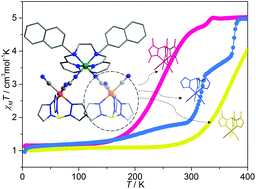Manipulating the spin crossover behavior in a series of {Fe III2FeII} complexes†
Abstract
Three cyanide-bridged {Fe2Fe} complexes of formula {[(TpR)Fe(CN)3]2[Fe(bnbpen)]}·S (TpR = Tp for 1·S, Tp3−Me for 2·S, and Tp* for 3·S, respectively; bnbpen = N,N′-bis-(2-naphthylmethyl)-N,N′-bis(2-picolyl)-ethylenediamine) have been prepared and characterized here. Single-crystal X-ray diffraction analysis revealed that all compounds feature right angled trinuclear structures with two [(TpR)Fe(CN)3]− units at the ends and one [Fe(bnbpen)]2+ at the centre. Besides the rich hydrogen bonds, remarkable π–π interactions are evidenced in all compounds between the intermolecular naphthyl and pyrazolyl rings. As a result, compounds 1·S and 2·S exhibit irreversible two-step and one-step spin-transitions, respectively, during the process of removing solvents, with T1/2 at 314 K and 376 K for 1·S and 350 K for 2·S, while compound 3·S shows a reversible one-step spin transition at relatively lower temperatures with T1/2 = 250 K, and what's more, an irreversible small magnetic change accompanied by the loss of lattice solvents was observed. The solvent-free compounds show SCO properties at lower temperatures than the corresponding solvated ones; however, the solvent-free compound 1 maintains an unexpected high-spin state and does not follow the trend that their transition temperatures decrease with the enhancement of the electron donor properties of the TpR ligands (Tp* < Tp3−Me < Tp), likely due to the more compact π–π stacking mode in comparison with those for compounds 2·S and 3·S.



 Please wait while we load your content...
Please wait while we load your content...